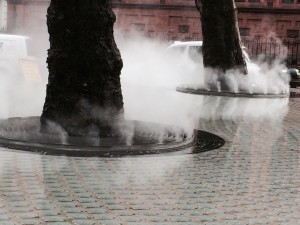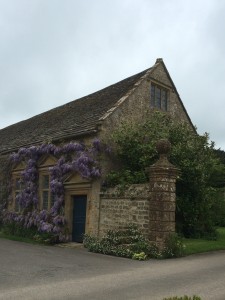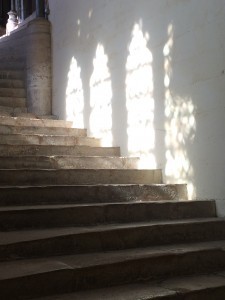Ten Tips for Tuning Up Your Descriptions
Kate Flora: There are so many challenges facing a writer who is trying to craft fiction that sometimes descriptions fall far down the list. By the time an author has developed a cast of characters, created a plot filled with twists and turns, and mastered the art of writing dialogue, descriptions can sometimes be left to old clichés or place-holders that await that moment when the author can revisit the work and give them a fresh, new twist.
But we all want our work to shine. Stand out from the vast fields of competing works.

How would you describe this?
Description is meant to be evocative and memorable. We want our books to be the ones that readers will clasp with delight as they say to a friend or significant other: Listen to this . . .
Engage all of your senses. Don’t just describe what can be seen. Describe what can be smelled. Heard. Touched. Perhaps even tasted. Engaging your senses as you try to write description will engage your reader’s sense when they read what you have written. It will locate them more fully and create a greater emotional attachment to your story.

Worn? Shabby? Ancient? Rustic? Draped in wisteria?
Dig deeper and try to find a fresh way of showing. We can talk about worn steps or peeling paint, and a reader will know what we mean. But are there other ways to convey the age of a house, or its long use or lack of repair? The paint rolled away from the weather clapboards like it was recoiling in distaste. The foot-worn centers of the steps were as swayed as a tired old horse. The shutters hung off the house like they were trying to escape. The house looked like it had simply given up. Since writing the dark and desolate can be easier than writing the bright and happy, try the same exercise with a house that’s immaculate or tenderly cared for.
Try writing exercises. Since everything we write must do double or triple duty, it’s great to plug into the wonderful exercise John Gardner offers in the Art of Fiction. It’s one I always use with my students to help them see how they can tell through indirection. The exercise is this: write a paragraph describing a building as seen by a man whose son has died in the war, without mentioning the son, or death, or the war. Then describe the same building from the point of view of someone is love without mentioning love or the lover. See how the description changes as the observing eye changes.
See through you character’s eyes. Figure out what sorts of things your central

Color and tone can set a mood. Reflections in the water can match reflections by a character
character is attuned to, and add those to that character’s inner narration, the way they describe the world themselves. How do they see other people? What characteristics might jump out, and how would they define it? Long ago, as I moved from my Thea Kozak series to my Joe Burgess series, I realized that Thea organizes her world in lists and details, while Joe is more attuned to nature. I need to keep that in mind as I move them through their worlds and play the game with myself of asking: How would Joe Burgess see this? How would Thea Kozak see this? How are they different and what makes them particular to this character?
What does your character carry? In Tim O’Brien’s The Things They Carried, a huge amount of information about the various members of his platoon is conveyed by the things they carry. Choosing certain items, or habits, or mannerisms for a character, either a central character, or someone your central character is observing, can be a very effective shorthand. If you struggle with this idea, you can always start with your purse or your pocket, or the glove box, console, or trunk of your car. What do you carry and what does it say about you? Now, what does your character carry?

Bathed in streaks of late afternoon light through a stained glass window
Color your world. It is perfectly easy to describe something as blue or green or red. But the world is full of wonderful color names, so why not use them? Color names can go in positive, even poetic directions, such as obsidian, cornflower, sapphire or celadon. They can also convey darkness, ugliness, or a sense of the distasteful. Try liver, puce, mole, or mud.
Set your world in motion. Just as the use of color can tune up your writing, so can the use of motion. You can have your character walk into a room, and that’s okay. It gets them there. But if the character bursts into the room, strolls into the room, shimmies into the room, or enters as though being chased by a bear, the scene will be more dynamic. Bring your powers of observation along as you go for a walk, or sit in a mall food court, or go to a farmer’s market or a country fair, and start people watching. People don’t move alike, and as you watch, be thinking about how you would describe what you see. A limp? A strut? A hesitation? Someone strolling through the world like she owns it or teeters along on shoes that are far too high, seeming perpetually on the verge of being launched forward. Sometimes people walk as though the weight of their depression is almost too heavy to carry. Observations like these deepen both the observer and the observed.
Steal from others. Not directly, of course. But it can be very helpful, in determining what appeals to you as a writer, and why, to keep a little notebook in which you write passages which particular appeal to you as you’re reading them. Don’t just copy the passage or mark it in a book. Take the time to write it out by hand. There is something about the act of copying that helps you to feel the rhythm and weigh of the language.
Expand your vocabulary. Get yourself a couple of great books to help you expand your descriptive vocabulary. On my shelf, I have a book called The Describer’s Dictionary by David Grambs, described as “a treasury of terms and literary quotations for readers and writers.” What could be better than pages of quotes and words to describe patterns or edges? Like this one: “Men swore. They pushed at the wheels with long oak poles and slashed at the oxen till their backs were crosshatched with bleeding welts and their noses ran pink foam.” John Gardner, Grendel. Useful to see how other writers have done it.
I also often turn to Rodale’s Synonym Finder. It’s Maine in the summertime, but there are those days when the fog rolls in. How might you describe the sounds on a foggy night? Muffled, muted, dampened, dead-sounding, flat, toneless, indistinct, distorted. I’ve always had fun making lists of words and tacking them to the wall as I am writing the scene.
Keep buying writing books. And read and read the ones that speak to you. Recently, at a library book sale, I found a book by Rebecca McClanahan called Word Painting: A Guide to Writing More Descriptively. It’s a great book to dip into if you’re feeling dull or uncreative.

Play with the contrasts of light and dark

Or dark and light. Match a character’s mood or create a contrast



